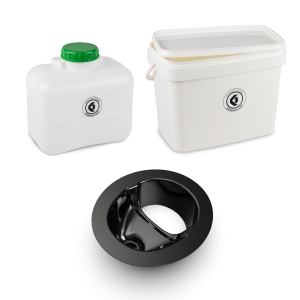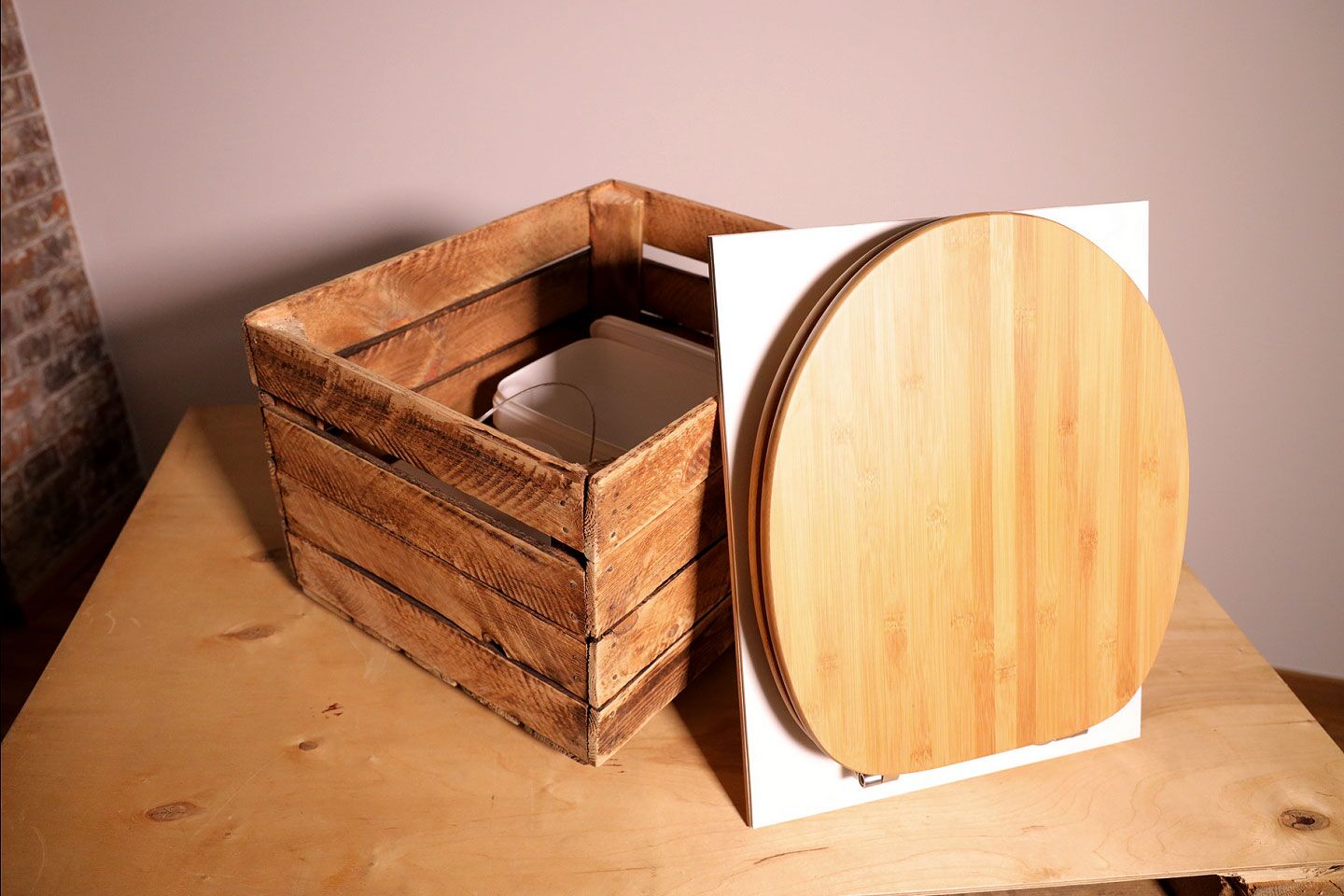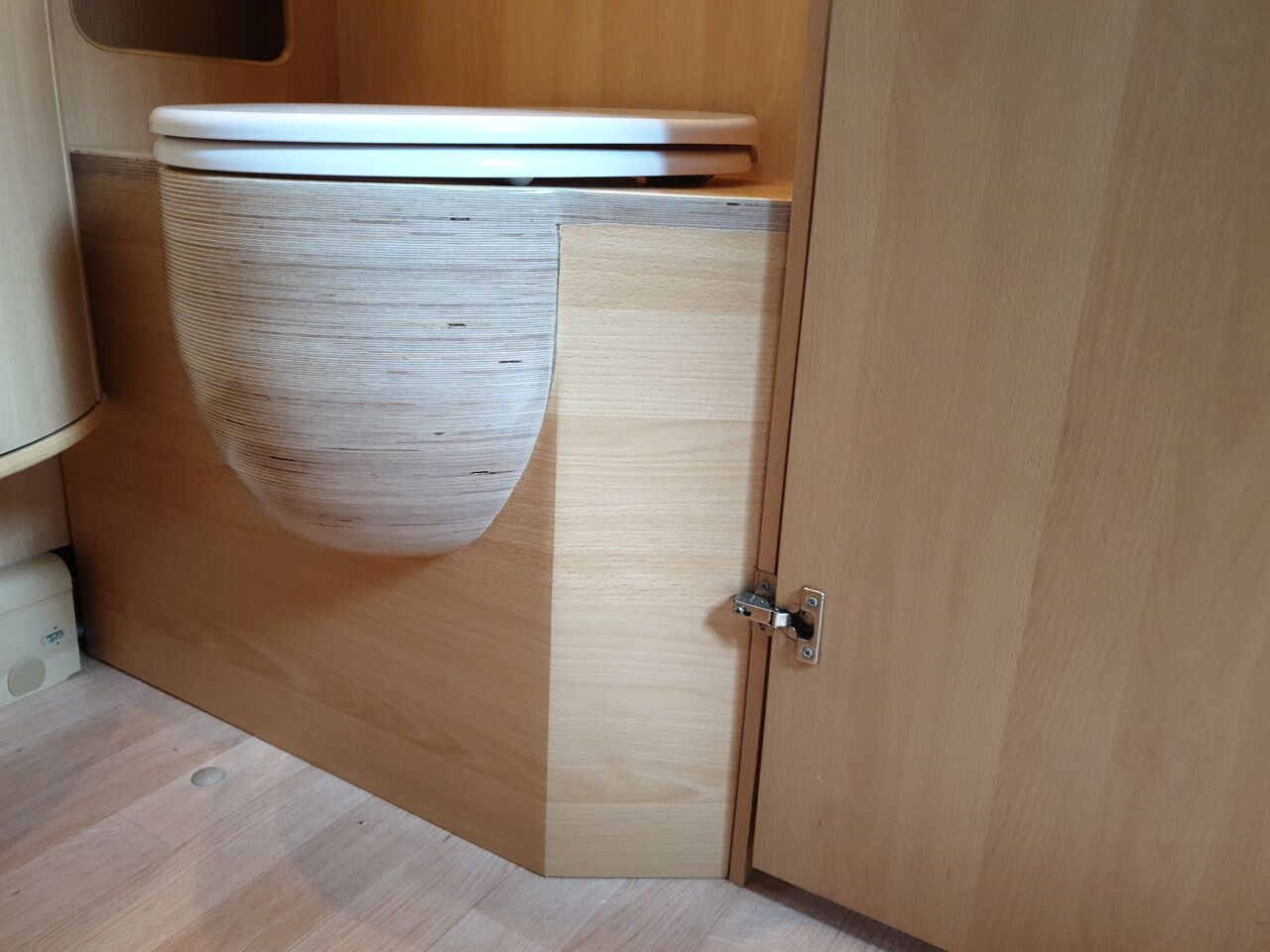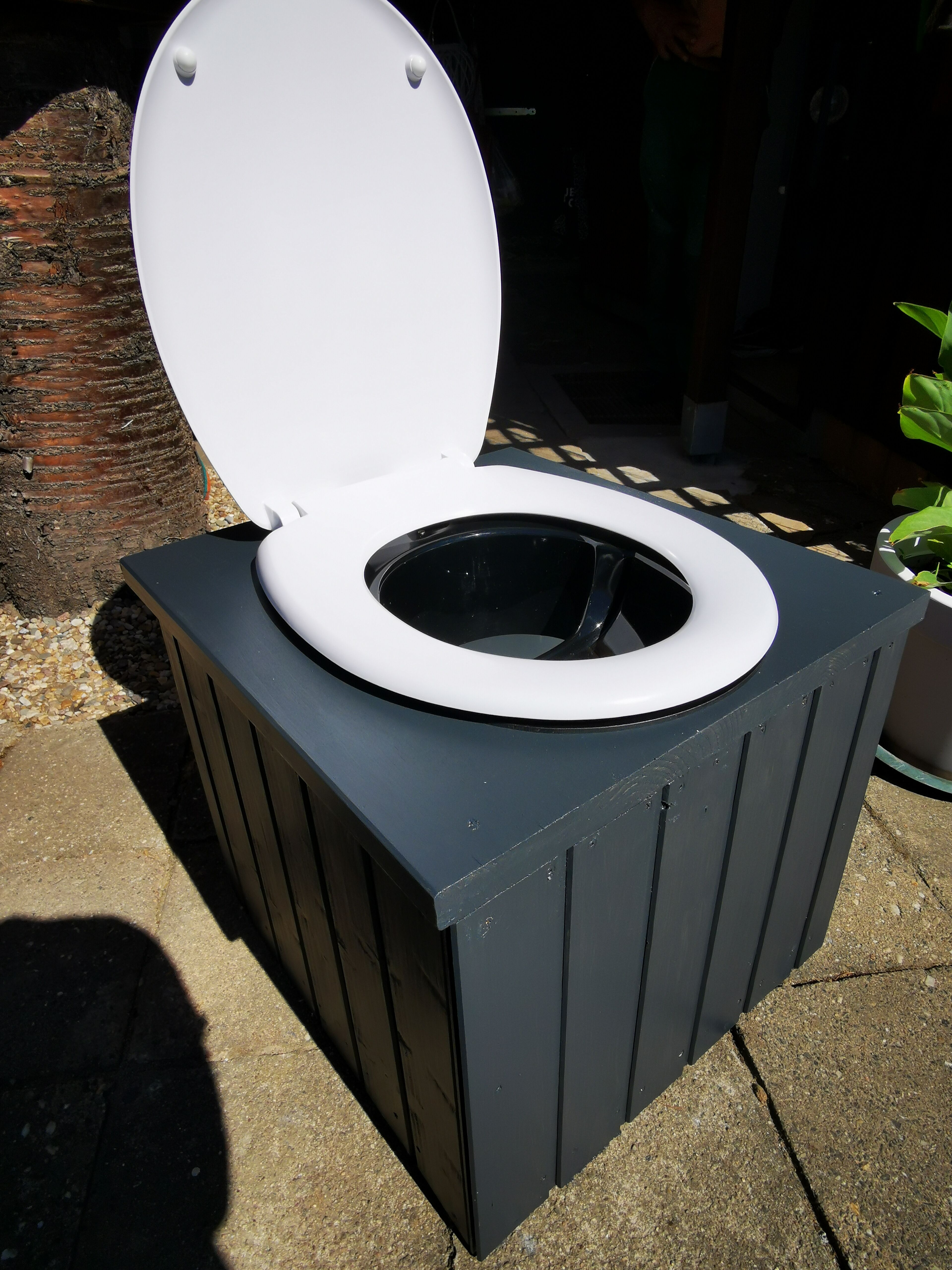-
MiniLoo composting toilet DIY kit
- separator insert with high-gloss finish
- high quality and robust finish
- load capacity toilet seat up to 150 kg
- magnetic toilet seat
- can be used as a stool
Go to item319,90 €incl. 19% VAT , plus shipping costsOld price: 379,90 €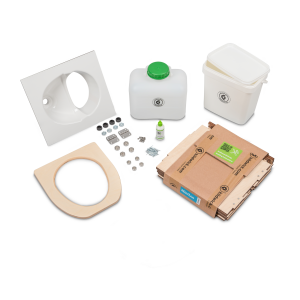 Go to item319,90 €incl. 19% VAT , plus shipping costsOld price: 379,90 €
Go to item319,90 €incl. 19% VAT , plus shipping costsOld price: 379,90 € -
Urine Separator Classic White
- original Kildwick urine diverter
- our best diverting Technology
- solid, high-quality finish
- easy to clean surface
Go to item79,00 €incl. 19% VAT , plus shipping costsOld price: 129,90 €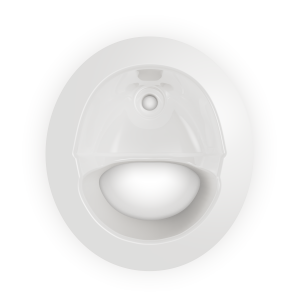 Go to item79,00 €incl. 19% VAT , plus shipping costsOld price: 129,90 €
Go to item79,00 €incl. 19% VAT , plus shipping costsOld price: 129,90 € -
Miscanthus Eco Litter 17 liter
- fast growing, organic material
- high absorbency and odor binding
- without pesticides
- 100 % compostable
- Climate neutral
Go to item14,90 €0,88 € per 1 lincl. 19% VAT , plus shipping costs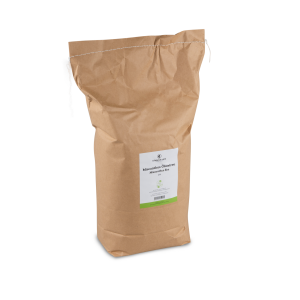 Go to item14,90 €0,88 € per 1 lincl. 19% VAT , plus shipping costs
Go to item14,90 €0,88 € per 1 lincl. 19% VAT , plus shipping costs -
FreeLoo L composting toilet DIY kit
- individual toilet construction possible
- separator with high gloss finish
- approx. 4mm material thickness
- bucket resistant to acids and alkalis
- canister food safe

D.I.Y. -
Build your own separation toilet:
Everything you need to know
You want to build a separation toilet yourself, but don't really know how? If so - you've come to the right place! In this article we will show you how to build your own dry toilet in just a few steps.
And it's not hard at all! If you're a bit handy and like to do things yourself, you'll have your separation toilet built in no time. And if not, a DIY kit will help you.
Are you ready? Then let's get started!Why build a separation toilet yourself?
Separating toilets (also called dry toilets) are not only practical camping toilets, but also really environmentally friendly. With a WC, each person uses an average of 35 liters of water per day just to flush their business. In the process, however, residues of medicines and chemicals end up in the environment as well, since these cannot be filtered completely by sewage treatment plants.
In comparison, a dry separation toilet uses 0 liters of water per day. If sustainability is important to you, separation toilets are definitely the right approach.
And now for the practical part: with a dry separation toilet, you don't have to give up the convenience of a toilet while being on the road with your camper. It also doesn't take up much space. Separation toilets are furthermore very useful if you have an allotment or a garden hut - but no water connection. Simply build your very own separation toilet - problem solved!
Other advantages of your self-build separation toilet are:
- You save water and costs as well.
- The dry separation toilet is assembled quick and easy
- and can be built from recycled/upcycled materials
Convinced? Good. But before you fire up the cordless screwdriver, here are a few important tips:
Build your own dry separation toilet: This is important
If you want to build your own dry separation toilet, you should consider the following things:
Important note: Read through these instructions completely before you start!
The choice of location
First of all, think about where you want to place your toilet. This is very important for the next step - measuring. At this point you should decide whether you want to install your portable toilet permanently or move it. For example, if you want to build your own separation toilet for the garden, you should install it permanently. Of course when traveling by camper, you should be able to take it with you or use your toilet outdoors at a scenic place :)
Size and dimensions
No matter whether it's a table, a cupboard or a dry separation toilet - building it yourself always means measuring it yourself! And do it carefully.
If you make mistakes, you will have problems putting the individual parts together later. And it would be a shame if the toilet seat didn't fit the hole at the end, wouldn't it?
You want to be on the safe side? If you use our DIY kits, e.g. the MiniLoo or the EasyLoo, you can save on this step!
The size of the seat is particularly important for the dimensions of the other parts. You can easily derive this from the toilet seat.
For the permanent version, you have to measure the length, width and depth of the base frame and the panelling.
Important: Write down all exact measurements! Otherwise you'll end up going to the DIY store for nothing…or twice ;)
The odour trap
Separating toilets don't have to smell bad. There is a diverter that separates liquid and solid waste. With the separator, your waste falls into two different containers: a solids tank and a urine tank. This already greatly minimizes odours. In addition, you can install a siphon. A siphon is a drainage pipe that prevents rising odours and prevents leakage up to a toilet slope of 40 degrees.
Another important role is played by the litter. It also has a neutralizing effect on odours by binding moisture. Read more about the right litter for portable toilets here.
And last but not least you can fit the canisters of your separation toilet with a lid that fits with a diverter in addition: for example, the Kildwick Spillguard Kit. This ensures that everything stays at it´s place during transport in the campervan, even on bumpy roads.
And if all that isn't enough, you can also equip your self-built separation toilet with a fan.
Ventilation: Yes or No?
If you want to build a separation toilet yourself, you might not think of ventilation first. In fact, 90% of the odours can be avoided by taking the measures described in the previous section.
Ventilation sounds pretty complicated. That's why we've developed the Kildwick vent kits for you. You can either install them while you're building your separation toilet, or you can install them afterwards.
Our 5V fan kit is easy to connect to a power supply via a mobile phone charging cable or the Kildwick solar panel thanks to its USB adapter, while our 12V fan kit connects directly to the 12V mains with its two-pin connector. The connection cables have two wire end sleeves, so you can freely decide how you would like to connect this fan. Whether Wago or luster terminals, soldering or other constructions - everything is possible. ...or simply order the complete kit for separation toilets with fan: To EasyLoo with fan
How does a dry toilet work?
Before you can build a separation toilet yourself, you should understand how it works. The building instructions will then be much easier to follow.
So: A dry separation toilet basically consists of 2 containers in a box that has a hole at the top. The toilet seat is mounted on the hole. A separator (also called a diverter) directs liquid and solid excreta separately into the 2 containers: the solid container in the back and the urine canister in the front of your toilet.
This is the basic principle of the dry toilet. With a few practical add-ons, however, you can make going to the toilet even more comfortable, for example with our ventilation systems for separation toilets.
Read more about this topic here: What is a dry separation toilet?
Build your own separation toilet: Step-by-step instructions
So, now you know everything you need to know and we can get started with the instructions on how to build a separation toilet yourself at a reasonable price:
Materials needed
You need...
For the interior:
1 PE canister (e.g. 13 litres) with an opening at the top in the middle (urine canister)
1 plastic bucket the size of a bathroom waste bin (solid waste container)
1 separating insert (urine separator)
For the construction (fixed installation):
Wooden slats and wooden boards/MDF panels corresponding to the size to be covered. Screws, angles
For the dry separation toilet "to go":
1 box that can hold you sitting down and is stable and that both containers fit into
1 suitable and flat (!) lid for the box
1 wooden board as a cover in the size of the box
Good glue (e.g. epoxy resin)
Other:
1 toilet seat with lid (toilet seat)
By the way: If everything is too complicated for you, buy a Kildwick kit for dry separation toilets. The toilet kit contains all the parts in the right size, so you don't have to saw or cut anything! More info in the shop.
Instructions for your dry separation toilet
Variant 1: Installing the separation toilet permanently as a bench
If you want to install your separation toilet permanently, follow these instructions:
Step 1: Measure
Measure the space you want to cover. This will also help you to find out how big the inside of your toilet can be. The advantage of fixed seperation toilets is that you have more space and can fit larger canisters.Then you can collect the materials in the required size or buy them at the DIY store.
Step 2: Build the basic structure
Once you have bought all the materials, the next step is to build the basic framework from the wooden slats. You can then screw the wooden or MDF panels for the panelling to these.
The procedure is as follows:
- Cut the wooden slats to size
- Build a "frame" from them and screw it together.
- Secure the frame to the walls and floor.
- Check the frame for stability: You should now already be able to sit on it (the frame supports the construction!).
Attention! When building the scaffold, make sure it is the right height to sit on! The scaffold should not be higher than 43 cm.
Step 3: Covering the base frame
Now you can cut the boards for the cladding and screw them on.
Attention! The top panel should have an opening the same size as the opening of the toilet seat, where the toilet seat will be placed. Make sure that the opening allows a comfortable sitting position. Also remember that the hole must be large enough for the canisters. Alternatively, you can attach the top plate with a hinge so that you can simply lift the entire plate, including the mounted toilet seat, to empty the canisters.
Tip: You can also cover your self-built separation toilet with tiles!
Step 4: Collecting tank & urine separator
Now it's time for the interior of your dry separation toilet:
- First place the solid container (bucket) in the back
- Then place the urine container in the front
- The containers should be placed in such a way that the urine separator can be positioned correctly on them: in a way that the openings of the diverter match those of both containers
- You may have to slightly adjust the position: Position the container for solids so that it matches the rear opening of the separator
Note: Building a urine separator yourself - is that a good idea? As a motivated do-it-yourselfer and self-made man or woman, you might also want to build the insert for the urine separator yourself. However, this is really only something for professionals. Because the shape is relatively demanding and so is the material: it has to be waterproof, easy to clean, easy to shape and yet stable. Therefore, instead of trying to make the urine separator yourself, we recommend buying a separator insert. You should not save money in the wrong place, because a good diverter is essential for good functioning and convenience of your separating toilet!
Step 5: Toilet seat & toilet lid
Your dry separation toilet is almost ready! Now it's just a matter of fitting the toilet seat. Most of the time, the toilet seat is already fitted to the toilet seat anyway.
Since most toilet seats are simply fastened with two screws and nuts, mounting them is not very difficult:
- Drill two holes in the wooden panel behind the opening at the right distance apart.
- Position the seat correctly
- Insert the screws through the holes from above.
- Tighten the nuts from below
And you've built your own separation toilet! But, wait...
Step 6: Install the ventilation (optional)
Depending on the type of ventilation, you may have to do this beforehand. It depends on the construction plan of the ventilation - just follow it. We would be happy to refer you to our assembly instructions, which you can find in the Kildwick Support.
Now let's take a look at how you can build the portable separation toilet yourself:
Variant 2: Build your own camping toilet as a portable separation toilet.
For the portable dry separation toilet for camping, the instructions are even simpler:
- Simply cut the wooden board to the size of the lid. It serves as reinforcement for the lid when you sit on it and to mount the toilet seat.
- Cut a hole the size of the toilet seat opening in both the lid and the wooden plate so that the two holes overlap exactly.
- Glue the wooden plate to the lid.
- Now put the divider on top (screw or glue).
- Glue or screw the toilet seat to the wooden plate with the separating insert glued to the lid.
- Continue with step 4 as explained for variation 1.
Note: If the lid is very stable, you can leave out the reinforcement by the wooden plate (but then you can only glue).
Variant 3: Separating toilet kit
Finally, you can of course build your perfect separation toilet with our simple Kildwick kits. The advantages are obvious:
- no hassle due to wrong measurements
- no hassle due to missing or mismatched parts
- no hassle due to unstable construction
- no loss of time
- easy and clean emptying
- easy and clean emptying
Check out our separation toilet kits here:
- MiniLoo HYDRO
- MiniLoo
- MicroLoo
- PiccoLoo
- EasyLoo
- FreeLoo (kit without paneling if you want to build the structure yourself)
- HappyLoo (camping toilet without separation)
With our Kildwick kits, your partition toilet will look great too. Best of all, you can customise your toilet to your own specifications. So individualists and creative minds will also get their money's worth with our kits.
These customers have built a separation toilet themselves - with success:
Conclusion: Build your own separation toilet or buy one?
Building a separation toilet yourself is definitely no rocket science - no matter whether you want to build a dry separation toilet for your garden or camping yourself. We do not recommend building the urine separator of the dry toilet yourself. With the Kildwick DIY kits, you can save yourself a lot of potential mishaps and have a lot of fun instead!
What material to use for a dry toilet?
To build a camping separation toilet yourself, you need a box with a lid, 2 containers - for solids and urine, a diverter and a toilet seat. A few screws are also needed. That's all it takes. For a fixed separation toilet, you need wooden slats and boards for the panelling instead of the box.
What kind of litter for a dry toilet?
The best litter for your dry toilet is our odour-neutralising Miscanthus litter or alternatively small animal litter.
Where should I dispose of the separation toilet?
If you build your toilet yourself, you can simply dismantle it for disposal and recycle the individual materials at a recycling or disposal station.
How do I build a dry toilet?
We have described in detail in the article how exactly you can build an outdoor separating toilet yourself. Basically, you have to decide in advance whether you want to build a portable or a permanently installed dry separation toilet.
Our product recommendations for your van, boat or tiny house
x
Please sign in to write a comment.
